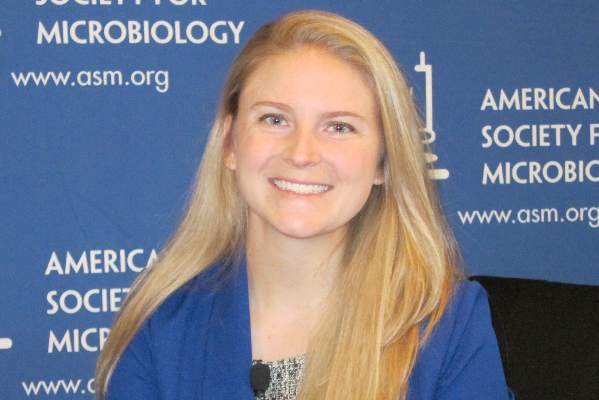User login
SAN DIEGO – Cefazolin is more effective, less toxic, easier to dose, and far less expensive than nafcillin; the current guideline-recommended first-line standard therapy for methicillin-susceptible Staphylococcus aureus (MSSA) bacteremia, Marguerite L. Monogue, Pharm.D., reported at the annual Interscience Conference on Antimicrobial Agents and Chemotherapy.
“These findings, coupled with the cost savings involved with using cefazolin over nafcillin, make it an appealing first-line agent for most MSSA bloodstream infections,” asserted Dr. Monogue of Hartford (Conn.) Hospital.
She presented a retrospective, nonrandomized cohort study involving 142 patients admitted to Parkland Hospital in Dallas for treatment of MSSA bacteremia due to endocarditis, osteomyelitis, pneumonia, or deep abscesses. Half started on nafcillin, the other half on cefazolin.
The treatment failure rate was 8.4% in the cefazolin group compared with 14% in the nafcillin-treated patients.
Moreover, the adverse event rate was 7% with cefazolin versus 19.7% with nafcillin. Nephrotoxicity was the main side effect; it occurred in 16.9% of the nafcillin group compared with 2.8% of those on cefazolin.
These study results are sure to draw the attention of hospital administrators because nafcillin costs a hefty 10-13 times more than cefazolin. Dr. Monogue estimated that Parkland Hospital would have saved nearly $100,000 if the 71 nafcillin-treated patients had instead received cefazolin.
“Some of these endocarditis and osteomyelitis patients are being treated for 6 weeks,” she noted.
Both drugs are beta-lactam antimicrobials. Their mechanisms of action are similar. However, nafcillin is classified as a penicillin, while cefazolin is considered a first-generation cephalosporin.
Nafcillin is dosed every 4 hours or by continuous infusion. Cefazolin is dosed once every 8 hours. Advantage cefazoline. Another dosing advantage favoring cefazolin is that at Parkland Hospital, patients can be discharged on cefazaolin and complete their treatment course at home, while if they’re on nafcillin they must remain in-hospital to finish their regimen.
Dr. Monogue reported having no financial conflicts with regard to this investigator-initiated, unfunded study.
SAN DIEGO – Cefazolin is more effective, less toxic, easier to dose, and far less expensive than nafcillin; the current guideline-recommended first-line standard therapy for methicillin-susceptible Staphylococcus aureus (MSSA) bacteremia, Marguerite L. Monogue, Pharm.D., reported at the annual Interscience Conference on Antimicrobial Agents and Chemotherapy.
“These findings, coupled with the cost savings involved with using cefazolin over nafcillin, make it an appealing first-line agent for most MSSA bloodstream infections,” asserted Dr. Monogue of Hartford (Conn.) Hospital.
She presented a retrospective, nonrandomized cohort study involving 142 patients admitted to Parkland Hospital in Dallas for treatment of MSSA bacteremia due to endocarditis, osteomyelitis, pneumonia, or deep abscesses. Half started on nafcillin, the other half on cefazolin.
The treatment failure rate was 8.4% in the cefazolin group compared with 14% in the nafcillin-treated patients.
Moreover, the adverse event rate was 7% with cefazolin versus 19.7% with nafcillin. Nephrotoxicity was the main side effect; it occurred in 16.9% of the nafcillin group compared with 2.8% of those on cefazolin.
These study results are sure to draw the attention of hospital administrators because nafcillin costs a hefty 10-13 times more than cefazolin. Dr. Monogue estimated that Parkland Hospital would have saved nearly $100,000 if the 71 nafcillin-treated patients had instead received cefazolin.
“Some of these endocarditis and osteomyelitis patients are being treated for 6 weeks,” she noted.
Both drugs are beta-lactam antimicrobials. Their mechanisms of action are similar. However, nafcillin is classified as a penicillin, while cefazolin is considered a first-generation cephalosporin.
Nafcillin is dosed every 4 hours or by continuous infusion. Cefazolin is dosed once every 8 hours. Advantage cefazoline. Another dosing advantage favoring cefazolin is that at Parkland Hospital, patients can be discharged on cefazaolin and complete their treatment course at home, while if they’re on nafcillin they must remain in-hospital to finish their regimen.
Dr. Monogue reported having no financial conflicts with regard to this investigator-initiated, unfunded study.
SAN DIEGO – Cefazolin is more effective, less toxic, easier to dose, and far less expensive than nafcillin; the current guideline-recommended first-line standard therapy for methicillin-susceptible Staphylococcus aureus (MSSA) bacteremia, Marguerite L. Monogue, Pharm.D., reported at the annual Interscience Conference on Antimicrobial Agents and Chemotherapy.
“These findings, coupled with the cost savings involved with using cefazolin over nafcillin, make it an appealing first-line agent for most MSSA bloodstream infections,” asserted Dr. Monogue of Hartford (Conn.) Hospital.
She presented a retrospective, nonrandomized cohort study involving 142 patients admitted to Parkland Hospital in Dallas for treatment of MSSA bacteremia due to endocarditis, osteomyelitis, pneumonia, or deep abscesses. Half started on nafcillin, the other half on cefazolin.
The treatment failure rate was 8.4% in the cefazolin group compared with 14% in the nafcillin-treated patients.
Moreover, the adverse event rate was 7% with cefazolin versus 19.7% with nafcillin. Nephrotoxicity was the main side effect; it occurred in 16.9% of the nafcillin group compared with 2.8% of those on cefazolin.
These study results are sure to draw the attention of hospital administrators because nafcillin costs a hefty 10-13 times more than cefazolin. Dr. Monogue estimated that Parkland Hospital would have saved nearly $100,000 if the 71 nafcillin-treated patients had instead received cefazolin.
“Some of these endocarditis and osteomyelitis patients are being treated for 6 weeks,” she noted.
Both drugs are beta-lactam antimicrobials. Their mechanisms of action are similar. However, nafcillin is classified as a penicillin, while cefazolin is considered a first-generation cephalosporin.
Nafcillin is dosed every 4 hours or by continuous infusion. Cefazolin is dosed once every 8 hours. Advantage cefazoline. Another dosing advantage favoring cefazolin is that at Parkland Hospital, patients can be discharged on cefazaolin and complete their treatment course at home, while if they’re on nafcillin they must remain in-hospital to finish their regimen.
Dr. Monogue reported having no financial conflicts with regard to this investigator-initiated, unfunded study.
AT ICAAC 2015
Key clinical point: The time is nigh for cefazolin to replace nafcillin as first-line therapy for methicillin-susceptible Staphylococcus aureus bacteremia.
Major finding: Treatment failure and adverse event rates were 8.4% and 7%, respectively, with cefazolin, compared with 14% and 19.7% with nafcillin.
Data source: This retrospective, nonrandomized cohort study included 142 patients hospitalized for methicillin-suscueptible Staphylococcus aureus bacteremia, with half started on current first-line nafcillin, the other half on cefazolin.
Disclosures: The presenter reported having no financial conflicts with regard to this investigator-initiated, unfunded study.

